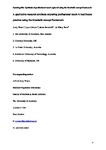A qualitative research synthesis exploring professional touch in healthcare practice using the threshold concept framework
| dc.contributor.author | Wearn, A | |
| dc.contributor.author | Clouder, L | |
| dc.contributor.author | Barradell, S | |
| dc.contributor.author | Neve, Hilary | |
| dc.date.accessioned | 2019-09-07T13:18:10Z | |
| dc.date.issued | 2020-08 | |
| dc.identifier.issn | 1382-4996 | |
| dc.identifier.issn | 1573-1677 | |
| dc.identifier.uri | http://hdl.handle.net/10026.1/14887 | |
| dc.description.abstract |
Touch is an integral part of human life. Consequently, touching and being touched are also fundamental to healthcare practice. Despite a significant literature on touch, it is rarely conceptualized or discussed in terms of the student journey from layperson to practitioner. We chose to explore professional touch using the threshold concepts framework (TCF), which provides a theoretical model for exploring the way in which learners encounter, engage with and understand fundamental concepts in a discipline. This qualitative research synthesis (QRS) describes the use of the TCF to identify key issues involved in developing and using professional touch. Through a cross-professional analysis and synthesis of recent international literature, we aimed to identify key characteristics of the transitional journey for professional touch. Three orders of analysis were applied, employing a methodology described by Major and Savin-Baden (An introduction to qualitative research synthesis: managing the information explosion in social science research, Routledge, London, 2010). Following identification of threshold characteristics in the overall sample of articles, second order analysis revealed the nuances of professional touch associated with the characteristics. The final synthesis led to identification of five themes: touch as dialogue; being changed by touch; multiple boundaries of touch; multiple meanings of touch and influences on touch. Whilst providing support for some assertions within the literature, this QRS also offers new insights into the complexity of professional touch. Given the paucity of explicit learning and reflection around professional touch in training programmes of health professionals, the TCF reveals ways in which professional preparation might be improved to promote understanding of the role and impact of touch in practice. | |
| dc.format.extent | 731-754 | |
| dc.format.medium | Print-Electronic | |
| dc.language | en | |
| dc.language.iso | en | |
| dc.publisher | Springer (part of Springer Nature) | |
| dc.subject | Health professions | |
| dc.subject | Professional touch | |
| dc.subject | Qualitative research synthesis | |
| dc.subject | Threshold concepts | |
| dc.title | A qualitative research synthesis exploring professional touch in healthcare practice using the threshold concept framework | |
| dc.type | journal-article | |
| dc.type | Journal Article | |
| dc.type | Research Support, Non-U.S. Gov't | |
| dc.type | Systematic Review | |
| plymouth.author-url | https://www.webofscience.com/api/gateway?GWVersion=2&SrcApp=PARTNER_APP&SrcAuth=LinksAMR&KeyUT=WOS:000547888500012&DestLinkType=FullRecord&DestApp=ALL_WOS&UsrCustomerID=11bb513d99f797142bcfeffcc58ea008 | |
| plymouth.issue | 3 | |
| plymouth.volume | 25 | |
| plymouth.publication-status | Published | |
| plymouth.journal | Advances in Health Sciences Education | |
| dc.identifier.doi | 10.1007/s10459-019-09901-9 | |
| plymouth.organisational-group | /Plymouth | |
| plymouth.organisational-group | /Plymouth/Faculty of Health | |
| plymouth.organisational-group | /Plymouth/Users by role | |
| dc.publisher.place | Netherlands | |
| dcterms.dateAccepted | 2019-06-26 | |
| dc.rights.embargodate | 2020-7-15 | |
| dc.identifier.eissn | 1573-1677 | |
| dc.rights.embargoperiod | Not known | |
| rioxxterms.version | Accepted Manuscript | |
| rioxxterms.versionofrecord | 10.1007/s10459-019-09901-9 | |
| rioxxterms.licenseref.uri | http://www.rioxx.net/licenses/all-rights-reserved | |
| rioxxterms.type | Journal Article/Review |


